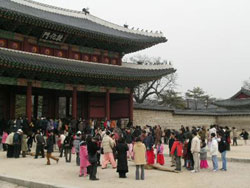
People gathered at Changgyeongung Palace
It's Chuseok, one of Korea's biggest holidays and a fine time to rejoice in the rich crop harvest and good friends.
On this joyous occasion, when people gather for good meals, good times and folk games, the Cultural Heritage Administration under the Culture Ministry has once again announced the opening of historic palace grounds for all to enjoy.
During the Chuseok Holiday from Sept. 13 to 15 a total of 19 historic sites including palaces, royal tombs and temples will be wide open for people to attend events and experience the flavors of Korean traditions and pastimes within.
Palace grounds Gyeongbokgung (Gyeongbok Palace) presents tightrope walking and a Bukcheong Lion Play in front of Geungjeongjeon (the Throne Hall) for two days on Sept. 13 and 14. The Bukcheong Lion Play was believed to shoo away evil spirits and pray for the well being of the town.
Other things to entertain visitors include gilnori (road play), pungmulnori (percussion play), and julgosa (sacrificial rite for the tightrope). Some 70 veteran tightrope walkers from an association for the preservation of national folk games will perform from 4 to 5:30 p.m. The event is in line with past royal records that detail festivities involving tightrope performances in front of Gyeonghoeru Pavilion and Sajeongjeon Council Hall.
Also from Sept. 13 to 15 there will be chances to play tuho (arrow throwing), yunnori (traditional board game), paeng-i-chigi (top spinning), jaegi-chagi (shuttlecock kicking) and other traditional games in front of Sujeongjeon Library Hall.
Deoksugung (Deoksu Palace) has a veritable truckload of traditional music performances.
On Sept. 13 Yiri Farm Music and the Bongsan Mask Dance will be staged at 2 p.m. and 4 p.m. respectively. On the 14th, Pyeongtaek Farm Music and the Gangryeong Mask Dance will take place also at 2 p.m. and 4 p.m. On the 15th, the Namsadang Play and Bukcheong Lion Play will be performed. For English information click
here.
Changgyeonggung (Changgyeong Palace) will open up the front yard of Yanghwadang Hall for traditional fun and games. For a fee of 5,000 won one can participate in making a dancheong plaque, dancheong mirror and others from 10:30 a.m. to 5 p.m. (Dancheong is a Korean traditional decorative coloring.)
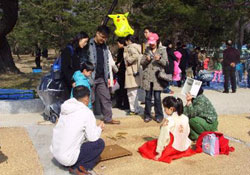
Korean traditional board game, Yunnori
Changgyeonggung has also just re-opened its glass greenhouse, which was under restoration for nearly a year. The first 600 people to visit it will receive postcards as souvenirs. For more information, click
here.
Changdeokgung (Changdeok Palace) may not have as much going on as other palaces, but it is providing free plum juice to those who visit on Chuseok Day on Sept. 14.
Note: The entrance fee to the palace grounds on Sept. 13 and 15 will be free only for those who are dressed in the Korean traditional attire of Hanbok. On the actual Chuseok Day (Sept. 14), all will be free to enter with or without Hanbok.
Royal tombs
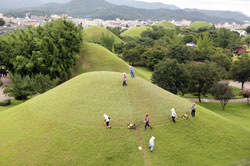
Gardeners preparing for the Chuseok opening at royal tombs
The royal tombs of the kings and queens of the Joseon Dynasty (1392-1910) are being made ready for more visitors than usual on the occasion of Chuseok. Traditional games and folk pastimes are all included in the day's event for sure, but also check out the distinctive souvenirs prepared for the occasion.
The Office of the Jongmyo Shrine, which houses tablets dedicated to the memorial services for the deceased kings and queens of the Joseon Dynasty (1392-1910) will offer free snapshots and hangwa (Korean snack) to the first 500 people to turn up. At Dongggureung, the biggest royal burial ground where 17 kings and queens sleep including King Taejo (1355-1408) the very founder of Joseon Dynasty, and Uireung, where King Gyeongjong (1688-1729) lies buried, snacks will also provide visitors.
Jeongneung, the royal tomb of Queen Sindeok (? - 1396), Hongyureung (Hongreung and Yureung) that belong to Emperor Gojong (1852-1919) and Empress Myeongseong (1851-1895) have prepared traditional game sets as gifts. Heolleung, where King Taejong (1367-1422) lies, will offer similar gifts to visitors who come in family groups of three generations.
Taereung, the royal tomb of Queen Munjeong (1501-1565) seems to have prepared the largest amount of souvenirs. Its management office will distribute booklets with stories of royal tombs of the Joseon Dynasty to the first 300 visitors, yut sticks for yunnori to the first 100, family trees depicting the royal lineage of the Joseon Dynasty to the first 300 and “hyojason” or back-scratchers to the first 500.
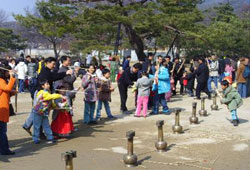
Arrow throwing game, tuho
Expats will especially appreciate the arrangements at Seolleung, the tomb of King Seongjong (1457-1494). Organizers will provide a guide in English at 2 p.m. on Sept. 15. After a half-hour explanation there will be a jaegi-chagi competition. The winner will receive a pretty apron made from a Hanbok garment. Rice cakes will be available as souvenirs. (
02-568-1291 , English spoken)
The same goes for Yungneung, tomb of Crown Prince Sado (1735-1762), where songpyeon rice cakes will be given away especially to migrant workers who visit. However, in order not to miss out, you had better hurry on Chuseok Day, for those gifts and snacks may run out very fast.
Other tomb sites of Seooreung, Gwangneung, Jangneung and three royal tombs of Paju will all be opened for Chuseok festivities. For more information call 042) 481-4701 or e-mail:
koreasoc@ocp.go.krShrine Management Office
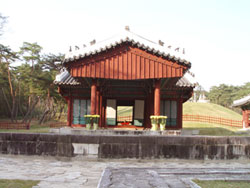
King Sejong's Yongreung Royal Tomb and shrine
The King Sejong Shrine Management Office, in charge of preserving and managing tombs of King Sejong (1397-1450), the greatest monarch of Joseon, who created Korea's writing system Hangeul, offers folk pastimes and the additional experience of printing a copper plate version of Hunminjeongeum (the first-ever instructions of how to use Hangeul).
People can also visit the tomb of King Hyojong (1619-1659) and see the displayed sundial, rain gauge, and musical instruments used back then.
Other folk festivals are being organized by the
Hyunchungsa Shrine Management Office, which is in charge of the preservation of Hyunchungsa Buddhist Temple and Chilbaekichong Shrine Management Office in Geumsan-gun County Chungcheongnam-do (South Chungcheong Province) whose shrine was established to commemorate the death of 700 loyal soldiers who fought against the Japanese invaders during the Imjin War (1592-1598).
For more information on Shrine Offices visit the website of the
Culture Heritage Administration.
By Kim Hee-sung
Korea.net Staff Writer